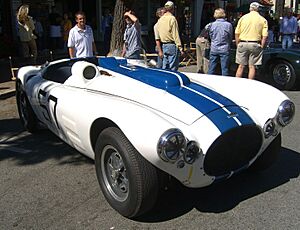Phil Walters facts for kids
Quick facts for kids Phil Walters |
|
|---|---|
| Nationality | |
| Born | April 20, 1916 New York City, US |
| Died | February 6, 2000 (aged 83) Homosassa, Florida, US |
Philip F. Walters (born April 20, 1916 – died February 6, 2000) was a famous American race car driver. He was known for winning two major races twice: the 12 Hours of Sebring and the Watkins Glen Grand Prix.
Contents
Early Racing Days
Phil Walters was born in New York City and grew up in Manhasset. When he was a teenager, he started racing small, fast cars called midgets on tracks in Long Island. He used a secret name, "Ted Tappett," so his family wouldn't know he was racing! People said his early driving style was very strong and aggressive.
War Hero and New Driving Style
In January 1942, Phil joined the United States Army Air Corps during World War II. He became a pilot for transport planes and gliders. During a difficult mission in the Netherlands, he safely landed his glider, even though he was hurt. He was taken prisoner by the Germans.
While in a German hospital, a German surgeon saved his life. This surgeon, surprisingly, had watched Phil win a midget race years before! Because of his injuries, Phil's strength was not the same. After the war, he changed his driving style. He became smoother and less forceful, which actually made him faster. This new style was perfect for sports car road racing. Phil finished the war as a Flight officer and received several awards, including the Air Medal and a Purple Heart.
Post-War Racing Success
After the war, Phil Walters went back to racing midget cars. He was incredibly successful, winning 26 races in a row in 1947! In 47 other races, he always finished in the top three. He was the first champion at the Riverside Park Speedway in 1949.
Later, he also raced stock cars (cars that look more like regular street cars). He won many races in these cars. Besides racing, Phil started a business with Bill Frick called Frick-Tappett Motors. They prepared race cars and built special high-performance cars called ‘Fordillacs’ (which had Cadillac engines in Ford car bodies). This business later became a dealership selling Volkswagen and Porsche cars.
The Cunningham Team Years (1950–1955)
In 1949, a wealthy racer named Briggs Cunningham bought a Fordillac. He wanted to race an all-American sports car in the famous 24 Hours of Le Mans race in France. He asked Phil Walters to join him. Soon, Phil became the general manager of the B. S. Cunningham Company. This company built the first American cars to race at Le Mans after the war.
Racing at Le Mans
The Le Mans organizers didn't allow the Fordillac, so Cunningham took two Cadillacs to the race in 1950. Phil Walters raced with Briggs Cunningham himself. They finished 11th in a uniquely shaped car nicknamed ‘Le Monstre’ (The Monster).
The Cunningham team set up a base in West Palm Beach, Florida, and aimed for the 1951 Le Mans race. Phil, now the Managing Director, teamed up with fellow American driver John Fitch. They raced very well, even reaching second place before finishing 18th. In 1952, Phil returned with Duane Carter, but their car had to stop early because of an engine problem.

In 1953, Phil Walters and John Fitch achieved a fantastic third place at Le Mans. Their car was even faster than the winning car from the year before! This was a huge achievement for an American team.
Sebring and Watkins Glen Wins
Phil Walters also won the 1953 12 Hours of Sebring race with John Fitch. This was a big win against top European teams in the first race of the World Sportscar Championship.
The Cunningham team also competed in the SCCA National Sports Car Championship series in the US. Phil won many races, including the Watkins Glen Grand Prix multiple times. He won three times at Watkins Glen: the Seneca Cup in 1950, and the Grand Prix in 1951 and 1954. In 1952, he set the fastest lap record on the original track, which still stands today! Phil was the only driver to win at Watkins Glen on both the original open-road course and the later closed circuit.
Retirement from Racing
Briggs Cunningham's dream of an all-American winning team ended after a fifth-place finish at the 1954 24 Hours of Le Mans. During his time with Cunningham, Phil drove many different sports cars, including Cunningham, O.S.C.A., Porsche, Cooper, Ferrari, and Jaguar. He won his second Sebring title in a Jaguar D-Type with British driver Mike Hawthorn.
Just before the 1955 Le Mans race, the famous car maker Enzo Ferrari offered Phil a spot on his Formula One team. However, Phil witnessed a terrible accident at Le Mans in 1955. A car crashed into the crowd, causing many deaths. Phil said, "I had gotten used to drivers killing each other, but I could not adjust to drivers killing spectators." At just 38 years old, he decided to leave motor racing for good.
Life After Racing
After leaving motor racing, Phil Walters became a very skilled sailboat racer. With his family as his crew, he won the challenging Block Island Regatta. His sailboat, a *Peterson 34* named OBSESSION, became famous for winning many races in the 1970s.
In his later years, Phil lived in Homosassa, Florida. Before that, he lived in Syosset and worked in Hicksville, New York. There, he ran a car dealership called Walters Donaldson VW-Porsche-Audi. Phil Walters passed away on February 6, 2000.

